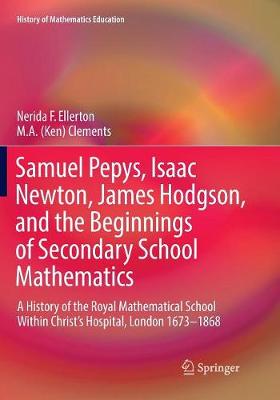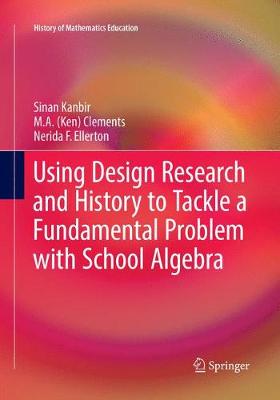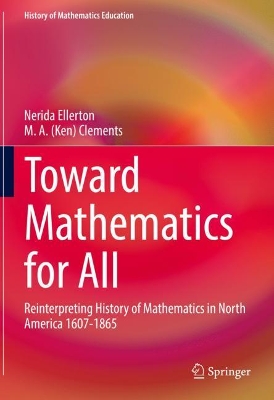History of Mathematics Education
3 total works
This book tells one of the greatest stories in the history of school mathematics. Two of the names in the title-Samuel Pepys and Isaac Newton-need no introduction, and this book draws attention to their special contributions to the history of school mathematics. According to Ellerton and Clements, during the last quarter of the seventeenth century Pepys and Newton were key players in defining what school mathematics beyond arithmetic and elementary geometry might look like. The scene at which most of the action occurred was Christ's Hospital, which was a school, ostensibly for the poor, in central London. The Royal Mathematical School (RMS) was established at Christ's Hospital in 1673.
It was the less well-known James Hodgson, a fine mathematician and RMS master between 1709 and 1755, who demonstrated that topics such as logarithms, plane and spherical trigonometry, and the application of these to navigation, might systematically and successfully be taught to 12- to 16-year-old school children. From a wider history-of-school-education perspective, this book tells how the world's first secondary-school mathematics program was created and how, slowly but surely, what was being achieved at RMS began to influence school mathematics in other parts of Great Britain, Europe, and America.
The book has been written from the perspective of the history of school mathematics. Ellerton and Clements's analyses of pertinent literature and of archival data, and their interpretations of those analyses, have led them to conclude that RMS was the first major school in the world to teach mathematics-beyond-arithmetic, on a systematic basis, to students aged between 12 and 16.
Throughout the book, Ellerton and Clements examine issues through the lens of a lag-time theoretical perspective. From a historiographical perspective, this book emphasizes how the history of RMS can be portrayed in very different ways, depending on the vantage point from which the history is written. The authors write from the vantage point of international developments in school mathematics education and, therefore, their history of RMS differs from all other histories of RMS, most of which were written from the perspective of the history of Christ's Hospital.
It was the less well-known James Hodgson, a fine mathematician and RMS master between 1709 and 1755, who demonstrated that topics such as logarithms, plane and spherical trigonometry, and the application of these to navigation, might systematically and successfully be taught to 12- to 16-year-old school children. From a wider history-of-school-education perspective, this book tells how the world's first secondary-school mathematics program was created and how, slowly but surely, what was being achieved at RMS began to influence school mathematics in other parts of Great Britain, Europe, and America.
The book has been written from the perspective of the history of school mathematics. Ellerton and Clements's analyses of pertinent literature and of archival data, and their interpretations of those analyses, have led them to conclude that RMS was the first major school in the world to teach mathematics-beyond-arithmetic, on a systematic basis, to students aged between 12 and 16.
Throughout the book, Ellerton and Clements examine issues through the lens of a lag-time theoretical perspective. From a historiographical perspective, this book emphasizes how the history of RMS can be portrayed in very different ways, depending on the vantage point from which the history is written. The authors write from the vantage point of international developments in school mathematics education and, therefore, their history of RMS differs from all other histories of RMS, most of which were written from the perspective of the history of Christ's Hospital.
Using Design Research and History to Tackle a Fundamental Problem with School Algebra
by Sinan Kanbir, M. A. (Ken) Clements, and Nerida F. Ellerton
Published 16 November 2017
In this well-illustrated book the authors, Sinan Kanbir, Ken Clements, and Nerida Ellerton, tackle a persistent, and universal, problem in school mathematics-why do so many middle-school and secondary-school students find it difficult to learn algebra well? What makes the book important are the unique features which comprise the design-research approach that the authors adopted in seeking a solution to the problem.
The first unique feature is that the authors offer an overview of the history of school algebra. Despite the fact that algebra has been an important component of secondary-school mathematics for more than three centuries, there has never been a comprehensive historical analysis of factors influencing the teaching and learning of that component.
The authors identify, through historical analysis, six purposes of school algebra: (a) algebra as a body of knowledge essential to higher mathematical and scientific studies, (b) algebra as generalized arithmetic, (c) algebra as a prerequisite for entry to higher studies, (d) algebra as offering a language and set of procedures for modeling real-life problems, (e) algebra as an aid to describing structural properties in elementary mathematics, and (f) algebra as a study of variables. They also raise the question whether school algebra represents a unidimensional trait.
Kanbir, Clements and Ellerton offer an unusual hybrid theoretical framework for their intervention study (by which seventh-grade students significantly improved their elementary algebra knowledge and skills). Their theoretical frame combined Charles Sanders Peirce's triadic signifier-interpretant-signified theory, which is in the realm of semiotics, with Johann Friedrich Herbart's theory of apperception, and Ken Clements' and Gina Del Campo's theory relating to the need to expand modes of communications in mathematics classrooms so that students engage in receptive and expressive modes. Practicing classroom teachers formed part of the research team.
This book appears in Springer's series on the "History of Mathematics Education." Not only does it include an important analysis of the history of school algebra, but it also adopts a theoretical frame which relies more on "theories from the past," than on contemporary theories in the field of mathematics education. The results of the well-designed classroom intervention are sufficiently impressive that the study might havecreated and illuminated a pathway for future researchers to take.
The first unique feature is that the authors offer an overview of the history of school algebra. Despite the fact that algebra has been an important component of secondary-school mathematics for more than three centuries, there has never been a comprehensive historical analysis of factors influencing the teaching and learning of that component.
The authors identify, through historical analysis, six purposes of school algebra: (a) algebra as a body of knowledge essential to higher mathematical and scientific studies, (b) algebra as generalized arithmetic, (c) algebra as a prerequisite for entry to higher studies, (d) algebra as offering a language and set of procedures for modeling real-life problems, (e) algebra as an aid to describing structural properties in elementary mathematics, and (f) algebra as a study of variables. They also raise the question whether school algebra represents a unidimensional trait.
Kanbir, Clements and Ellerton offer an unusual hybrid theoretical framework for their intervention study (by which seventh-grade students significantly improved their elementary algebra knowledge and skills). Their theoretical frame combined Charles Sanders Peirce's triadic signifier-interpretant-signified theory, which is in the realm of semiotics, with Johann Friedrich Herbart's theory of apperception, and Ken Clements' and Gina Del Campo's theory relating to the need to expand modes of communications in mathematics classrooms so that students engage in receptive and expressive modes. Practicing classroom teachers formed part of the research team.
This book appears in Springer's series on the "History of Mathematics Education." Not only does it include an important analysis of the history of school algebra, but it also adopts a theoretical frame which relies more on "theories from the past," than on contemporary theories in the field of mathematics education. The results of the well-designed classroom intervention are sufficiently impressive that the study might havecreated and illuminated a pathway for future researchers to take.
This book presents a history of mathematic between 1607 and 1865 in that part of mainland North America which is north of Mexico but excludes the present-day Canada and Alaska. Unlike most other histories of mathematics now available, the emphasis is on the gradual emergence of "mathematics for all" programs and associated changes in thinking which drove this emergence. The book takes account of changing ideas about intended, implemented and attained mathematics curricula for learners of all ages. It also pays attention to the mathematics itself, and to how it was taught and learned.


